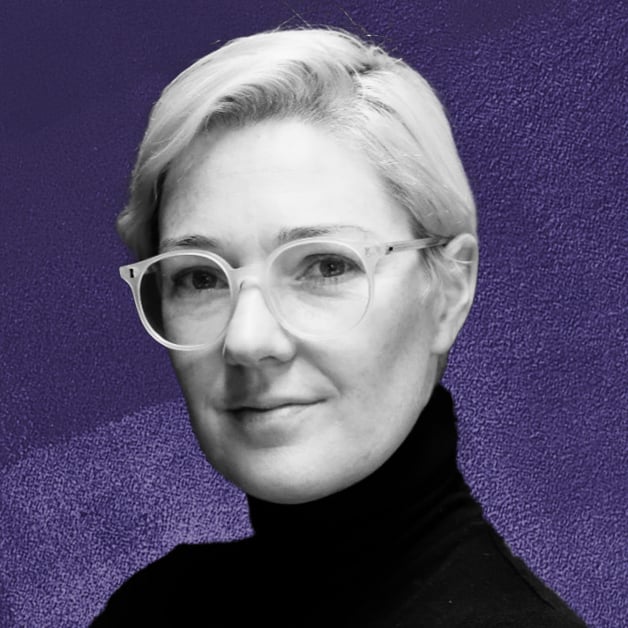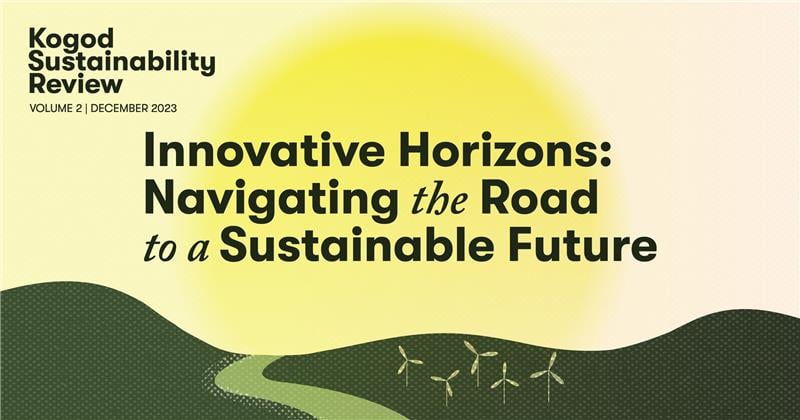
Sheik Azharuddin
MS in Sustainability Management Student, Kogod School of Business
As you embark on your new role as an editor, brimming with energy and passion to contribute to your organization, you find yourself facing a dilemma. You've been tasked with writing on sustainability. It's an ever-developing field with a broad umbrella covering areas such as the environment, science, social issues, finance, technology, and more. The challenge is that even experts in this field are not clear about the subject matter. So, how does one report on such a vast and complex topic? What's the best source? Is it the internet or a source deeply immersed in the industry? As a firm believer in "hands-on experience," I've chosen the latter, and my quest for a true innovator in sustainability led me to Brooke Roberts-Islam.
Brooke Roberts-Islam, a notable figure in the field of sustainability, is a senior journalist for Forbes. She is a distinguished writer, author, and founder of Techstyler, a consulting firm based in the UK focused on sustainability and innovation in the fashion and textile industries. Her previous career delved into medical imaging and knitwear design, providing her with hands-on experience in fashion design, textile manufacturing, product development, and garment production. She is the voice for individuals without a voice in the textile and garment industry, advocating for their rights and echoing their opinions to the textile and garment industry worldwide.
Sheik: Hello Brooke! Thanks for taking the time to connect. Following the Rana Plaza incident in 2012, a decade has passed, what are significant changes you see in the industry?
BR: After the industrial accident, there was a significant shift in factory safety marked by the implementation of the Bangladesh Accord, now known as the International Accord, which led to significant refinement in its rules and policies. The Accord played a crucial role in transforming the ready-made garment (RMG) sector, not only in Bangladesh but globally. It has set standards for safety regulations and ensured the independent freedom of association for workers, particularly vital in developing countries where most garment manufacturing occurs.
This development is pivotal in the history of the ready-made garment sector, addressing safety concerns not only in Bangladesh but also in manufacturing countries worldwide. During the Rana Plaza accident, brands were aware of the working conditions but managed to shift responsibility solely onto manufacturers.
As mentioned in one of my articles, the implementation of the Bangladesh Accord initially created a power imbalance, with brands absolving themselves of responsibility and dictating terms to manufacturers. This approach hindered the implementation of the Accord, which could have been more collaborative with manufacturers. Recognizing that safety was an industry-wide problem, the Accord highlighted the need for all stakeholders, including brands and manufacturers, to work together for meaningful change.
I was reading one of your articles that made me question how fast fashion is often villainized, would you mind shedding some light on how fast fashion is being held responsible as "the scapegoat?"
Sustainable fashion lacks a clear legislative definition in Europe, particularly in terms of fast fashion. It is understood as clothing produced in large volumes, at accessible prices, and with quick market turnover. Rather than adhering to seasonal or longer lead time production, fast fashion is known for frequent production, often irrespective of consumer demand, aiming to drive unabated consumption. “Fast fashion” gained prominence following the success of brands like Zara and H&M, the latter being founded in the fifties.
There is a prevalent notion that the volume and pricing of goods are the sole determinants of sustainability in the fashion industry, which appears to be shaped by dominant luxury brands, aligning them with sustainability and longevity; while fast fashion brands like Zara and H&M face heightened criticism for being environmentally harmful.
This elitist narrative perpetuates the notion that buying expensive designer goods is sustainable, while purchasing from fast fashion brands are environmentally harmful."

Brooke Roberts-Islam
Founder of TECHSTYLER, Senior Contributor at Forbes
This oversimplified narrative neglects the shared supply chains of luxury, premium, and fast fashion brands. Raw materials like cotton are brand-agnostic. Luxury and premium brands may not be doing as much as they could be when it comes to sustainability due to the belief that their practices are inherently sustainable. A more specific, data-driven analysis is necessary to address sustainability issues, moving beyond perception and elitism.
If it's not the location or the brand that determines the sustainable fashion products, what key factors or indicators should the consumer look for to determine a sustainable product?
Answering this question is challenging yet essential, as it involves different facets of sustainability. It’s important to consider not just consumption volumes, but duration of use when determining the environmental footprint. The more often a garment is worn and the longer the duration of life the better. A thorough investigation into the brand's practices, production locations, and treatment of stakeholders becomes crucial when it comes to analyzing brand sustainability efforts. When evaluating a specific purchase, I would prioritize the durability of the material and its potential for long-term use without excessive dry cleaning or washing.
For instance, in performance sportswear, where durability is paramount, I've observed that synthetic materials tend to outlast their cotton counterparts, for example. Despite concerns about fossil fuel- based polyester and microplastics, the longer lifespan can offset such drawbacks.
In essence, a pragmatic approach involves assessing the practicality of the garment, its intended use, and its potential longevity.
Is circular fashion the answer to sustainable fashion? If yes, what is the role of consumers in circularity?
Circular fashion is a partial answer within the broader context for conducting fashion business while staying within planetary boundaries. It is crucial but not the sole solution. Clean and renewable energy are the first, most important answers.
Circularity typically implies recycling, but interpretations vary based between stakeholders in the fashion value chain. From a consumer perspective, circularity includes rental, resale, mending, and extending product life. Despite being branded as powerful, these actions resemble practices
from past generations and there is no empirical evidence to demonstrate that they lead to a reduction in the purchase of new garments. Circular fashion, from a consumer point of view, typically means repair, reuse, resell or rent.
Nevertheless, consumers shouldn't be led to believe that these actions alone can save the industry. There is no empirical evidence to demonstrate that fashion rental, resale, and repair reduce the industry's overall footprint. True circularity involves closing the loop on the textile waste problem. Until that's solved, the missing piece of the puzzle for rounding out Fashion Circular is just not there.
There is absolutely no data that I've been presented that indicates that the increase in rental and resale has coincided with a decrease in the sale of brand-new products."

Brooke Roberts-Islam
Founder of TECHSTYLER, Senior Contributor at Forbes
Companies often tout their introduction of resale or rental initiatives as ‘sustainable’, but there is a lack of data demonstrating a decrease in the sale of brand-new products. There is absolutely no data that I've been presented that indicates that the increase in rental and resale has coincided with a decrease in the sale of brand-new products.
A comprehensive understanding of sustainability is essential, recognizing a hierarchy of actions. It's also crucial to acknowledge that our impact on the planet extends beyond the fashion industry across other areas of our daily lives.
When discussing our individual footprints, I always highlight a valuable resource called Project Drawdown, which provides a comprehensive list of potential actions to mitigate anthropogenic climate change. By prioritizing actions based on their potential to reduce greenhouse gas emissions, the list underscores the most effective ways to make a difference. At the top of this list are critical actions such as addressing food waste, avoiding deforestation, and safeguarding marine habitats, and the education of women and girls is in the top ten recommended actions as well. These actions represent the practical and impactful measures that consumers should consider when addressing climate change in their lifestyles.
From your point of view, is ESG/impact/social investing playing a significant role in the textile or the Ready-Made Garment (RMG) sector?
ESG investments typically revolve around a US or Eurocentric framework and risk analysis. ESG funds primarily invest in companies based on their ESG ratings, a measure of resilience against ESG-related risks, not of investment in ESG solutions.
When considering investments in the RMG sector with a focus on sustainability solutions, current trends involve relatively low-level investments in guaranteed Return on Investment (ROI) efficiencies and upgrades. Organizations like the Apparel Impact Institute (AII) and initiatives by Fashion for Good, such as the Good Fashion Fund, conduct facility assessments for a fee. These assessments identify opportunities for improvements and efficiency upgrades, along with calculating associated CAPEX costs and the period for achieving ROI.
However, these investments primarily address efficiency and upgrades and fall short of addressing more substantial climate targets that require significant capital expenditures and
fundamental infrastructure changes. The larger-scale investments needed to meet ambitious climate goals are not being adequately addressed due to several factors which I outlined in a recent report I co-authored with the Transformers Foundation.
From where you stand, what can you state about the mindset of the stakeholders of the top organizations about sustainability?
Every stakeholder in profit-making companies has a primary role: to deliver profits for shareholders, according to corporate law. However, the context for this delivery has shifted. 'The imperative for businesses now is to internalize what was once considered external, since climate change clearly poses a material financial risk
Climate change and ensuring supply chain disruption doesn't conform to economic market principles. It demands collaboration, an understanding of feasibility and decisions as to who will bear the cost of transformations in supply chains. The belief among industry experts is that brands haven't internalized this shift.
Partnership recognition is crucial since the RMG manufacturing sector can't solely finance these changes. 'Decarbonizing energy and altering processes, such as reducing wet processing and dependency on fossil-fuel intensive dye stuffs, are more practical considerations. Rather than endless debates, direct action based on practical, economic, and geographical factors is essential.
I don't aim to diminish anyone, but the key to progress lies in involving climate scientists, on-the-ground RMG experts, engineers, and brands in a collaborative partnership that acknowledges the challenges and accommodates allowances, be they economic or product-related. 'That's the honest 'how' in this scenario.
Final question Brooke—and this one is personal to me. As a student, which are the urgent/key areas where we as a student should focus? What are the skills set as a student we should develop?
When addressing a situation that is unprecedented, a critical skill is communication. Doing thorough research, knowing your topic, and conveying your informed beliefs and knowledge are essential, irrespective of your job or chosen path. When tackling topics like the climate crisis, reliance on provable facts, scientific consensus, and on-the-ground realities is crucial, especially in an age rife with misinformation and disinformation. As a journalist, I often have to contend with unsubstantiated information about ‘sustainable fashion’.
Data-driven research should be your approach to sustainability, period."

Brooke Roberts-Islam
Founder of TECHSTYLER, Senior Contributor at Forbes
Sustainability professionals have a duty to conduct accurate, well-informed research, utilizing credible sources and avoiding misrepresentations. Data-driven research should be your approach to sustainability, period.
Citations
- Brooke Roberts-Islam, “Global Fashion Summit—Focus Needed, Notable Absentees, And The O Word”, Forbes, July 4, 2023, https://www.forbes.com/sites/brookerobertsislam/2023/07/04/global-fashion-summit-focus-needed-notable-absentees-and-the-o-word/?sh=74234b8317f9
- Brooke Roberts-Islam, “Fast Fashion Is The Industry’s Sustainability Scapegoat. Here’s Why That’s Wrong, And What Should Happen.”, Forbes, Oct 12, 2023, https://www.forbes.com/sites/brookerobertsislam/2023/10/12/fast-fashion-is-the-industrys-sustainability-scapegoat-heres-why-its-dangerous-and-what-should-happen/?sh=55e3a4da2431
- Elizabeth L. Cline, Kim van der Weerd, Brooke Roberts-Islam, “Towards a Collective Approach: Rethinking Fashion’s Doomed Climate Strategy”, Transformer Foundation, 2023, https://www.transformersfoundation.org/annual-report-2023
